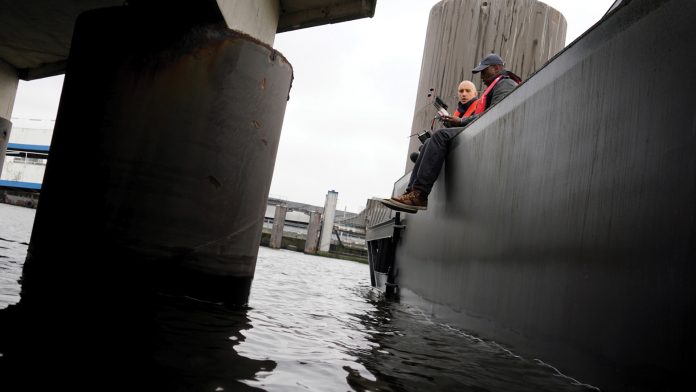Why continue to try and inspect a jetty in the traditional way when new, cost effective methods are now available with drone technology?
Maintenance inspection of jetties is not an everyday job and has been postponed in the past. At the same time, tank storage companies rely on 24/7 operations for the continuous availability of their jetty infrastructure. A jetty that is out of order for repairs, maintenance or inspection has a significant negative impact on the profitability of the company and has further implications on their customers. Since the jetty often doesn’t have an alternative, it is the navel cord of a storage company.
In Western Europe, many tank terminals were built in the 1950s and some later in the 1970s, making some of the infrastructure more than 50 years old. To keep these structures in good condition to moor oil and chemical tankers safely, an inspection must take place at least once every five years. With a thorough inspection, reporting and monitoring, a program of timely maintenance can prevent longer outage of these core facilities.
Currently, jetty inspections are performed in a relatively traditional way; a maintenance expert in a rowing boat does his utmost to get a picture of the underside of the jetty. To do this, she must row the boat as close to the structure as possible, in order to inspect and take images. However, while doing this she is limited by the amount of piles and height. Yet, even if there is enough height, it is still difficult to inspect a surface at four or five metres high, from an unstable moving boat. The jetty is not designed for such inspections; therefore, this leaves the activity not without risks. Of course, scaffolding can give access to these areas more safely, but such an approach would block the jetty for a longer period. It is not merely the inspection itself that is difficult: the inspector’s knowledge and experience also has an impact on the quality of the inspection and therefore concluding that this way to inspect does not always give a clear representation of the situation.
So why continue to try and inspect a jetty in the traditional way, while there are new, cost effective methods now available with drone technology? This does not mean flying drones, but sailing drones with camera facilities that remotely inspect jetties. If every five years an operational stop is needed to inspect a jetty, the use of the aqua-drone allows the process to be completed quicker, more efficiently and it covers the entire structure without the need of inspectors working in dangerous situations. The result of this process is a 3D model, which covers every square inch and gives all possible visual details. This drawing can then be uploaded in most popular CAD programs. The maintenance department are then given the opportunity to get a clear picture of the jetty’s condition, and subsequently develop maintenance programs and send an accurate request for quotations.
Jetty maintenance inspection by AquaSMartXL in the port of Rotterdam
Covering 105 square kilometres, the Port of Rotterdam is the largest port in Europe. The area itself is a heavily industrial environment and to ensure the safety of the people working in such an atmosphere, a regular inspection of the workplace must be performed. Located in the Botlek area is a tank terminal with a jetty for chemical tankers. This jetty has recently undergone an inspection to determine the maintenance that is required, before an intended reconstruction. Previously, once every five years, the operation of the tank terminal had to stop for several days in order to inspect the concrete quality of the jetties. Additionally, in this case, inspectors went beneath, in a small boat, so that they could examine the underside of the jetty. However, this is not ideal, as it entails safety hazards.
The most recent project that AquaSmartXL performed on the jetty was done for three reasons:
- To reduce the safety hazard;
- To reduce the out of operation time; and
- To create a 3D model as basis for planned reconstruction of the jetty.
AquaSmartXL performed the inspection by using a small sailing drone. The advantage of using a sailing drone to carry out an inspection is that the time taken for the inspection is shortened, which also shortens the maintenance time. In addition, inspectors no longer need to go beneath the jetty, which allows for the avoidance of any safety hazards.
Workflow
First of all, a surveyor measured approximately twenty control points, using a total station and marked them with small yellow stickers. Then the sailing drone was used to capture pictures of the underside of the jetty. It was of high importance to make sure that the stickers were visible on the majority of the images. With the use of software, a 3D model has been created. Coordinate system was configured in their local system and the control points measured by the surveyor were entered into the software. In the next step, the model was scaled to the control points. Lastly, the final model was exported in format, which meant that the customer could load into their software to perform clash detection and further construction investigation.
Overall, approximately 7000 images were captured in order to create a 3D model and thus visualise an as-built situation of the jetty. The on-site data capturing lasted one day. Subsequent data processing took roughly a week. Due to the changing weather conditions, the data set lacked the desired quality. Despite the weather factors, they successfully delivered an exact and detailed 3D model of the jetty to the customer. The 3D modelling software that was used is fast and it allows us to take many pictures, without lots of constraints on where the images must be taken. It generates brilliant 3D models that can be scaled to measured coordinates.
Advantages of aqua-drones
To conclude, this aqua-drone inspection method has several benefits. Firstly, the inspectors do not have to go underneath the jetty anymore. The drone will do this job for them. This work method reduces the safety risks during the data gathering of the inspection. The inspection itself can be done behind a desk, by an inspector specialising in concrete and steel structures. Secondly, the inspection does not have to interfere with the jetty operation: the jetty is typically highly occupied; and therefore downtime incurs direct loss to the tank terminal operator and their clients. Due to flexible operation of the drones, inspections can easily be executed between two moorings.
In addition to this, another benefit is that the drones can be transported in flight cases, making them operational around the world within days, and also all of the data is stored in a program which helps the inspector to navigate, zoom in and put notes to specific areas. Moreover, it is important to note that from the images, a 3D model can be created by photogrammetry. Continually, the total station approach makes the 3D model highly accurate.
One of the benefits of the 3D model is the navigation between the thousands of high definition pictures. From behind a desk the inspector can easily go to the parts of the structure that he wants to analyse in more detail. The 3D models of the inspections are comparable. This makes it possible to show changes of the structure overtime. Not only corrosion but also collision damage. These changes over time are the basis to develop a preventive maintenance program or RCM. The 3D model can also be used to maintain the drawings archive. A comparison of the drawings with the 3D model can show differences between the as built and the reality. The pictures and the 3D model can also be used for insurance purposes.
Marlon Drinkwaard
AquaSmartXL
+31 (0)657567791
marlon.drinkwaard@aquasmartxl.com
http://aquasmartxl.com








